Saleswhale Blog | 20 Min Read
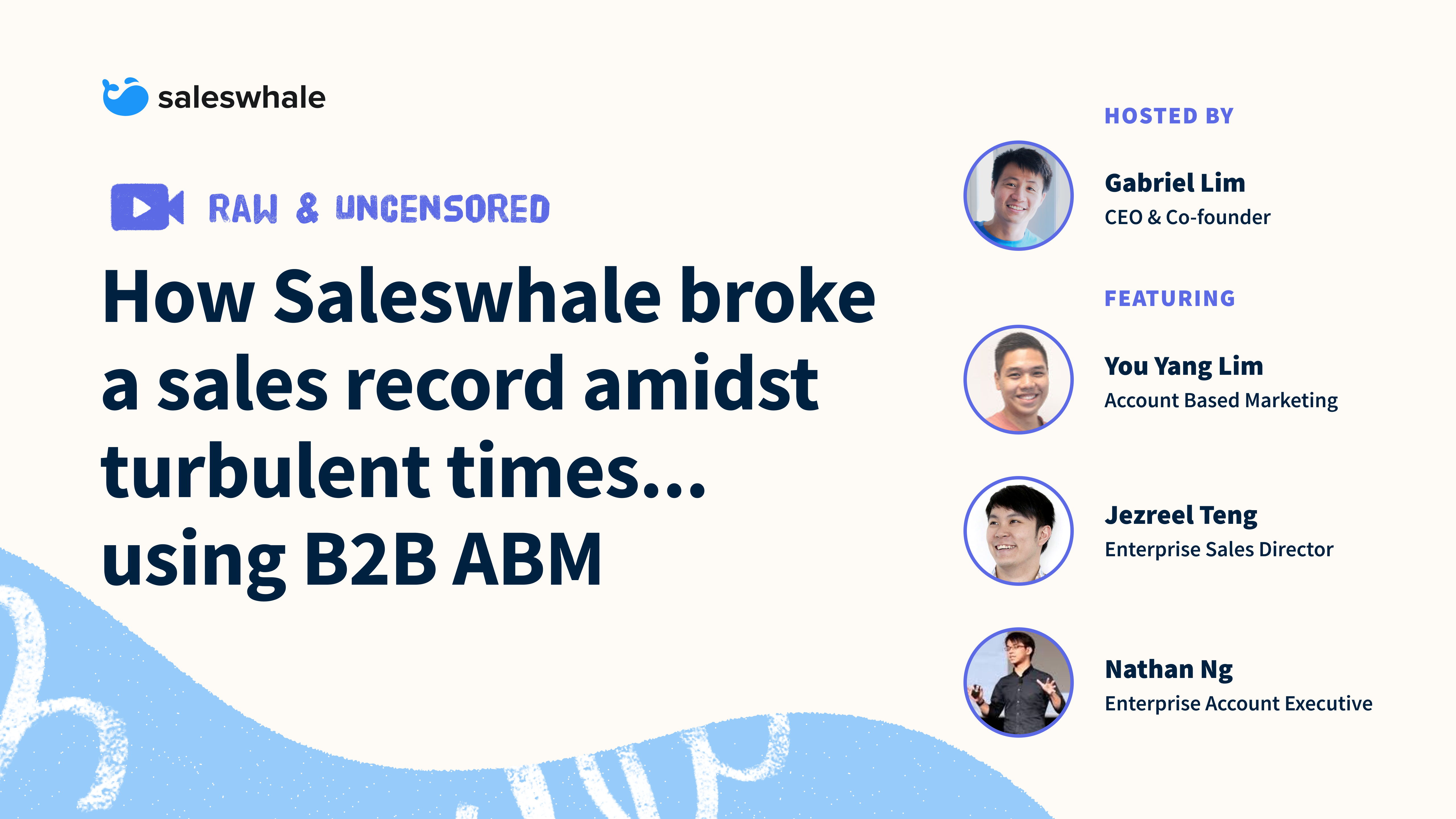
In March 2020, we broke a sales record at Saleswhale - closing more net-new business than Q3 / Q4 2019 combined.
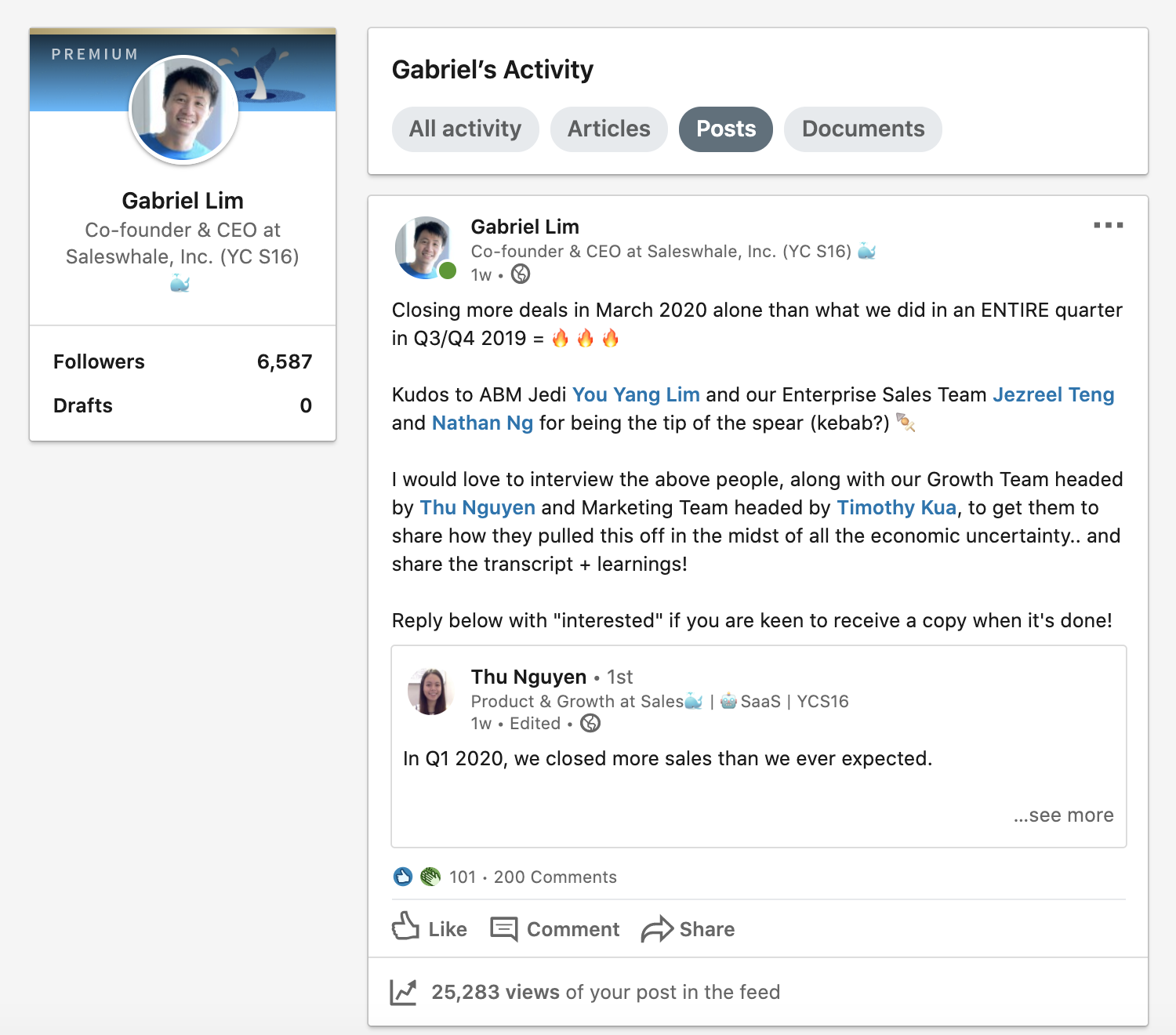 from: https://www.linkedin.com/posts/penguingab_growth-marketing-activity-6655472314026688512-Ihx7/
from: https://www.linkedin.com/posts/penguingab_growth-marketing-activity-6655472314026688512-Ihx7/
We know that many other B2B companies are likely to be struggling to hit top-of-the-funnel and pipeline goals, so I decided to moderate a webinar session with my Sales and Marketing teams to figure out how they did the impossible during these turbulent times.
The webinar was also 100% unscripted and we did it all in one take (no rehearsals) - just to keep the whole thing super casual and "real".
Check out the full video + transcript below!
TRANSCRIPT
Gabriel: My name is Gabriel, co-founder and CEO of Saleswhale. This is our very first webinar that we are doing. Last week, my Head of Growth, Thu, she posted this fateful LinkedIn post -
[incomprehensible]
Gabriel: Can you guys see my screen?
Whales: Yup.
Gabriel: In Q1 2020, we closed more deals than we expected. And for more context: in the month of March alone we actually closed more net-new business than we did for the entire quarters of Q3 and Q4 combined - and that was crazy right?
So, I kind of posted this post, and said - "Hey, reply below if you're interested to find out about what we do"
And I was joking with Thu that if we get more than 20 people who say, "they are interested" then we'll probably shoot an on-demand webinar and write a blog post about this. And guess what happened?
In less than one week, we had 115 people replying to say they're interested.
And I told Thu that, "oh shit, does this mean that I have to do this webinar now?"
So this is where we are - this is why we are here.
So where I want to start - I have my team here today with me.
So I would love for them to introduce themselves. And this can be like a casual conversation about what we did over the last four months that actually caused us to have this spectacular month in March. Especially when so many startups are struggling to close new business, to maintain top of the funnel leads with this whole coronavirus situation that's happening globally.
So yeah, Timothy do you want to begin introducing yourself?
Tim: Yeah sure, I'm Tim - I run marketing in Saleswhale joined sometime middle of last year - that's me.
Cherie: Hi, my name is Cherie, I am a Year Three National University of Singapore student. I study digital marketing and I am very passionate about anything related to sales and marketing. It's actually my second day of work, so I'm really here to ask questions from a layman perspective and wanting to find out insights about how the company strategizes moving forward.
Gabriel: Nice, cool. You Yang?
Yang: Hey, my name is You Yang. I run ABM (Account Based Marketing) and sales development. I joined about roughly a year ago.
Gabriel: So, you weren't doing ABM all the way right, you joined as an SDR?
Yang: No, no. Up till December last year, I was a SDR.
Gabriel: Jezreel, we can't hear you. You are on mute.
Jezreel: Hey this is Jezreel, once again. I am an Enterprise Account Executive. I get the leads from You Yang, and I close them for him.
Gabriel: Nathan? Ex-Salesforce guy.
Nathan: Yup, that's basically who I am. Doing enterprise deals now for Saleswhale. Working with Jezreel, my "best buddy".
Gabriel: Cool. So we have three Marketing people and two Sales people on this call. And my job is to grill them about what did they do, exactly, that caused us to have such a huge month in March 2020. So I guess let's start from the very beginning.
Things were not always like this. For the longest time, Saleswhale like many other B2B startups, was struggling with generating top of the funnel leads we were struggling with closing these deals, right? In fact, for a very long period of time our growth was very flat and it was really lumpy.
You Yang, do you want to take us through, from back in 2019 - what what were we doing in terms of lead generation? So this was before Timothy joined, right?
Timothy's our VP of Marketing he joined us on the 1st of August 2019.
This was way before Timothy joined us.
What were we doing then, and you know and what were the struggles that we were facing?
Yang: So before Tim joined, we had very little marketing activity or even any budget in the first place so a huge part of our pipeline, like 70 to 80 percent came from SDRs and they were cold outbound opportunities.
Gabriel: So you went on LinkedIn, you searched for people, scraped emails and and sent them mass emails?
Yang: Yeah, not mass emails, but emails that appeal to a certain vertical and how our product helps for that vertical. And that was our process day to day.
Gabriel: Just out of curiosity, how many emails were you sending weekly, monthly? How many leads were you reaching out to?
Yang: I guess maybe a hundred plus emails. If you looked at it from an Account perspective maybe 50 to 100 accounts.
Gabriel: Per week? Wow, that's a lot. Were you able to get demos then?
Yang: We were somewhat successful in getting demos, but our problem in 2019 and even 2018, was - one, it was very inconsistent in terms of closing. We were great at generating a lot of pipeline from outbound but a lot of them weren't closing. The closing rate was less than 5% for outbound demos.
Gabriel: How many demos were you guys generating, if you recall on a month-to-month basis back in 2018 and 2019?
Yang: Each SDR had a quota of 10 demos generated. We had an SDR manager and 2 SDRs. We were somewhat hitting our quota, or at least 80 percent of quota every month.
Gabriel: So roughly 20 demos every month total? But the issue was that these demos were not turning into closed-won opportunities. Back then, Jezreel was with us as well. I would love to hear from Jezreel - back in 2019, from your perspective how was it like taking a lot these demos the SDR team generated through cold outbound outreach?
Jezreel: I think the main difference between the outbound generated demos as compared to the inbound ones they were obviously a lot colder. But more than that, it is the level of readiness. As much as they were willing to speak to us, a lot of times they are not fully qualified. They might be the wrong people. They might not be in the state, or they don't have the authority to spend. And that gave us a lot of problems because we were spending so much time doing the 20-30 demos, but they were simply not closing much.
Gabriel: Would you say that they probably took the demo without really understanding what Saleswhale was - what the problem we were trying to solve was, and and a lot of time had to be spent educating them? The sales cycles were very long.
Jezreel: Yeah, you are right. A lot of them may even mistake us for chatbots, which we are not.
Gabriel: Got it. And this went on for what? The better part of early 2019? Three entire quarters of this. Every single month was a slog.
Jezreel: Yeah, we were just trying to increase the numbers because the conversion rate was so low. So we just tried to increase the top (of the funnel) numbers but the team becomes worn out after a while.
Gabriel: I can imagine - and it's probably pretty tiring and demoralizing for the SDR team, as well.
So what changed?
The inflection, or the trigger, that caused us to relook at what we'red doing was when Timothy joined us on the 1st of August 2019 as our VP Marketing. So, I heard some very funny stories from what happened. So maybe I'd love to hear from Timothy - your perspective on what you did when you first came in. And the scare that you gave my entire SDR team when you first joined.
Tim: Yeah sure absolutely. I think when I joined the first week, just like any new leader or manager that comes in you just want to dig into what's going on seeing what works, what doesn't work. And there were a lot of things.
But one thing that stuck out to me - the SDR team which is like three of them. They were reporting into my function. I think one of things that that's really struck me - They were doing a good job hitting the targets - in terms of the number of demos they managed to get for the sales team. But when I look back in the last two or three quarters, almost nothing was closing.
Which was very worrying, right? Because an entire function of three people, using a lot of expensive software, fixed costs, even if they hit their demo targets, we do need to look to the bottom line to see if they are actually converting into revenue. So I think at the end of the first week I organized a little marketing offsite.
Really meant to just get to know each other, right?
Gabriel: The fateful offsite! Tell us more.
Tim: I did mention at least for the SDR function, you guys are doing a great job but it's worrying on a company-level - that none of your demos are closing. And we're gonna try and solve this problem. And if we don't, we might have to repurpose your roles into something else that could work.
Gabriel: That's not what I heard. Yang, from your perspective, what did it sound like? When you heard, "this is not working. We have to repurpose the team." What did this sound like?
Yang: Yeah, "repurpose" sounded to us like you were getting fired.
Do we have to start finding new jobs? I just joined the company a few months ago, am I going to get fired already?
[laughter]
Tim: That came out the wrong way. But it is important right? To try and figure out how things can be better. I came up with a few ideas about maybe SDR handling inbound and qualifying inbound versus outbound.
I did bring up a few tactics, even ABM was one of them. But I honestly wasn't even sure if it would materialize. Who would take a charge on it.
Gabriel: Hmm. Cool. The way I heard story was like - this new VP Marketing flamboyantly walks in the room and says, "Hey the numbers are not good. If you guys don't shape up I'm going to fire all of you."
Tim: I never said - I never said anything remotely close to that!
[laughter]
Gabriel: Jokes aside, what happened after that was - Yang came to me and we were talking about how we can make things better.
Did the whole idea of this ABM - Walk me through, You Yang, what happened then? Why did we decide to do things differently? How did the whole idea of ABM or this initiative called "Starbucks" come about?
Yang: After the marketing kick-off and towards the end of December last year - Gabriel, you and I we were talking about how can we improve the opportunities brought in from outbound and one of the things was we needed to really focus on the accounts we are reaching out to, and the people within these accounts.
And I remember you came back from the US and you talked to this SDR manager and you guys talked about "gifting".
Gabriel: Shoutout to Nick Dowell from ZeroDown!
Yang: How "gifting" helped his outbound and how he generated like $1 million dollars in ROI just from a $10,000 budget. So we wanted to explore doing a Saleswhale version of that. What we decided on initially was a "gifting" kind of campaign.
Gabriel: It's more of an experiment right? It was something we were doing under the radar, trying not to attract too much attention.
Yang: Yeah, we kept it simple. You pick your best set of accounts - your dream accounts - you think are highly likely to buy for sure run them through an outbound cadence and "gift" them something to push them to take a demo.
Gabriel: How about marketing air-cover?
Yang: Yeah. So from there we went to do a little research, and that turned into ABM. We were reading a lot about ABM and how to do ABM from a startup's perspective. We had a demand generation manager then we talked about it and what happened was we end up running a marketing air-cover / SDR outreach campaign to a set of accounts. For a month to six weeks, we worked on the same set of accounts.
Gabriel: So I would like to double-click here. Let's start with the number of accounts. How many accounts did we shortlist for the very first "Starbucks" campaign? And why is it called the Starbucks campaign?
Yang: Yeah - it's a funny story. We were deciding on what type of gifts to give to people. We wanted something that was universally accepted and liked. Something that could be redeemed immediately.
Gabriel: I think we had a lot of weird ideas, right? Like giving chocolates, giving cakes, Amazon gift cards.
Yang: But in the end we decided - make it simple, something that's instantly redeemable, and that's how we ended up with Starbucks gift cards - and hence the codename "Starbucks".
Gabriel: What's the value of the gift cards? Like 5 dollars? 15 dollars?
Yang: 10 to 20 dollars.
Gabriel: What does that get me? Like a Frappuccino and a cake?
Yang: Yeah, yeah.
Gabriel: So that's how the name "Starbucks" came about. The whole idea was centred around gifting. We gave gift cards to decision makers. So how many accounts did we start with? Do you remember?
Yang: Yeah. So in that first experiment - Starbucks version one we targeted 30 accounts.
Gabriel: What was the budget? I remember you had to go to Reshma, our finance manager, and beg her for budget to run this initiative.
Yang: It's kind of funny so I went to her and we talked about it and you asked to secure budget, right?
So I went to Reshma and I talked to her, "Can I get six hundred dollars to buy a bunch of Starbucks giftcards?"
[censored]
It turned out well. We managed to secure our funding, and managed to kickstart our ABM process.
Gabriel: Perfect. So 30 accounts. Let's skip to the end. Spoiler alert. Out of these 30 accounts, how many actually turned into opportunities? How many demos did we secure?
Yang: In that first version - of that 30 accounts, we ended up having a 36 percent conversion rate from account to demo. That's about 11 demos. And from there, we had 8 real pipeline opportunities, or SALs (sales accepted leads).
Gabriel: That's crazy. That's phenomenal.
Yang: Yeah. From there, we had 2 deals that progressed to the verbal commit, then closed-won stages.
Gabriel: This is from the very first Starbucks campaign right? And we ran a couple more after that. So walk me through what was so different in terms of the process?
From the marketing air cover, to the email messaging, to the segmentation. What was so different with this ABM campaign that you ran compared to the cold outbound / mass outreach when you were a SDR?
Yang: Yeah I think from a fundamental perspective.. an operational perspective, you look at an SDR - their job is to get as many demos in a month as possible. And they have to hit a quota.
So they're incentivized to get as many demos as possible. Go after the lowest hanging fruits.
In terms of ABM, that's the opposite, right?
You're focusing on choosing your best accounts, targeting them and really educating them about your space and the problems you're trying to solve.
Gabriel: So are you saying that you spend more effort upfront to find what we call best-fit accounts. These are people you know for sure would be a good fit for our software and you also spend time to educate them on the space. To spend more time at the top of the funnel to send them collaterals, materials? How did you do it?
Yang: Yeah. So one thing that really worked well for us was we had a one singular value proposition we used. And it was a very clear on what problem we're trying to solve and how are we working with the particular verticals.
We stretched that across our ads. There were case studies. There were blog articles. White papers. That pointed prospects towards the problem we wanted to solve. That really worked out well for us because what happened was - we had that compounding brand awareness from our ads, from SDR outreach, even our website. We had that one coherent message. And it was very clear. If our target accounts had that problem that we were trying to solve, they responded well to our messaging.
Gabriel: So what I'm hearing now is - a lot of the work was the upfront account selection. The marketing air-cover. Educating the prospects. So where does the gifting come in, then? Was it really useful?
If you ran a regression, are people who receive the gifts are more likely to take the demos? Did that really work, or was it just a gimmick?
Yang: I think it'd be good to bring up the two versions that we ran for Starbucks. Version one - the entire process was centred around the gifting. So we were pushing demos - pushing accounts towards that gifting. We thought of that gift as the main driver for demos and opportunities. After that, we realize that, the gifting is really is the tipping point. The main drivers of the opportunities and how the opportunities close was that process of education. Teaching your accounts or prospects what you're trying to solve, how you are going help them - and that really worked well for us.
Gabriel: So you're saying the gifting was actually the tipping point to push someone who might not otherwise take a demo - given that a lot of our decision makers are really busy people. Push them over the edge to say, "Okay, fine, I'll take a 15 minutes phone call or 20 minutes demo"
Yang: If I have one piece of advice, don't think of your gifts as the main driver. Don't spend all your money on it. Spend your efforts on your efforts on crafting relevant messaging. Making it coherent across different channels. And really choosing the right accounts, and personas.
Gabriel: That's good advice. I would love to hear more from the Account Executives point of view. I would love to start with Jezreel. What was the difference between the demos that you were taking from this ABM campaign compared to the demos you were taking in early part of 2019 from the SDR team?
Jezreel: Although both of them are outbound leads, those that came in through ABM were a lot more well informed, in terms of what Saleswhale solves for. So they took the demo knowing that this is a solution that can help solve my problem, instead of - "what does your software do?"
It starts off the conversation very differently. Especially in an environment where we are tied for time. These are decision-makers - C-level sometimes - they don't have time to sit through an hour with us. Rather than spending half the session trying to explain to them what Saleswhale does, working ABM leads allows us to cut to the chase and immediately go into -
"This is the problem."
"This is the workflow."
"This is how we can help."
It really makes the whole dynamics of the conversation different and a lot more effective.
Gabriel: Interesting. What you're saying is that these people came in with a very clear understanding of the space that we are in. The problem we are solving, and they are primed and pre-disposed to find out more about the solution already.
Jezreel: Yeah. You are right.
Gabriel: Nathan, I heard that you closed an ABM deal - I mean, we obviously cannot name the company - in 8 days flat.
From first demo to closing a five-figure contract with this customer in eight days flat. I would love to hear more about that.
Tim: That's a record right? Is that a record still?
Gabriel: Uh - is it? No no no. The record is with Jezreel.
I cannot name the company but there was a deal that closed in 24 hours. The record is still held by Jezreel. I'll share with you guys which customer this is after the call. So Nathan, tell us about the deal you closed in 8 days. What what did the prospect say?
How much did they know about Saleswhale?
Nathan: It was like a deal served on a plate for me. I was talking to the decision maker who could decide on purchasing a software for her own team here in APAC. She was already very familiar with what Saleswhale is doing because of Yang - hitting her with all the marketing air-cover, all the ads. The messaging. Showed her videos as well about what Saleswhale is doing.
It was really a deal that was served on a plate. I just needed to go in to do more discovery. To share more about the use cases. To identify the common use cases she could possibly leverage. Especially during these uncertain times right? Let's say webinars - If they're doing more webinars, they want to use Saleswhale AI assistants to invite their prospects over - coordinating with marketing automation. So that really helped me to close the deal within 8 days.
One more thing I would like to share. I was telling Yang at that time - you are doing way better than all the BDRs in my previous company.
[laughter]
Gabriel: His previous company is Salesforce.
Nathan: Yeah. I think Yang was doing a really good job. Giving us hot leads to talk to. It's like nothing I've seen in my previous company.
Cherie: Can I ask something? Just for context, what's the average sales cycle length for Saleswhale?
Gabriel: I would love to bounce this back to the AEs. Jezreel, what was the average sales cycle for you back in 2019?
Jezreel: About four to six weeks.
Tim: There were some that went a bit longer right? Deals that have gone on for months.
Jezreel: Definitely.
Gabriel: I had a deal that took almost one year, eight months to close.
[laughter]
[cross-talk]
Gabriel: I would love to double-click on that. Nathan brought up something very interesting earlier - something about "these uncertain times". Obviously, we are now in an "unprecedented time" - so I apologize if this is your fifth time hearing this phrase from vendors this week. With this whole COVID situation that's burning, a lot of companies are slashing budgets. Cutting their spend. Being a lot more rigorous in terms of what they choose to invest in.
So I'd love to find out more from the sales people like Jezreel and Nathan, how did you guys convince these decision makers that now is the right time to spend? What are some of the tips and tricks you can share our audience - who may be struggling with pushing deals over the finishing line - especially during this period now?
Jezreel: I think for Saleswhale, it's slightly better, fortunately. Because we are a ROI-driving tool and also a cost-saving tool at the same time. As long as the client is not in the situation where HQ says that there's a budget freeze, clients are typically quite open - because they are still trying to make things happen, and make things work in their company.
They are also trying to find other ways to take a step forward. If we are able to educate them correctly on the positioning, and how we can add value - helping them make things easier during this difficult time, I think clients will still come aboard.
Gabriel: What you are saying is to reposition and reframe the product in a way that shows how you can help these customers in this time.
But how did the messaging and value proposition evolve? Did you tweak or change your value proposition or messaging during this whole coronavirus period, versus before that? Or it's mostly the same?
Jezreel: There's some changes. Instead of - In the past, we used to focus more on "maximizing your ROI"
Gabriel: Driving top-line growth.
Jezreel: People now are struggling to hit their numbers. People are concerned on getting from a below average state, to a state where they are able to meet their targets. In the past, our positioning was around trying to help customers push from a "meeting targets" state to an "exceeding targets" state. Actually, it's the same value proposition.
You are basically moving the numbers upwards still - But framing it in a way to what is important to our customers, and what they are trying to focus on at this moment.
Gabriel: Interesting. Nathan, do you have anything to add to that? How are you positioning yourself and the product differently now, and why are people buying now? How do you convince them?
Nathan: I think in every crisis there's always opportunity. Back at Salesforce, we always identified deals by compelling events. Is there a compelling event that makes the client want to sign and purchase this solution.
[cross-talk]
I mean not just the outbreak - If they are moving full on from events into webinars, that's a good space for us right now to be in. To actually sell webinar tools or any tools to help invite prospects, or engage prospects after the event. So once you identified those compelling events, you're likely to accelerate the deal itself.
Gabriel: I really like the way that you're framing this. So basically if you look at this whole COVID situation as a compelling event - tied back to what they are doing, to their own response plans - like you said, some of them are shifting to webinars. And how we fit into these response plans and use that as a lever to accelerate the deal. Yeah, and I probably have something to add as well.
Sorry for hijacking the conversation here. I think another I'm hurdle that I see a lot of our decision makers have to overcome - is their CFO, or their finance managers. Recently, we closed a $200,000 deal. It's a $200,000 annual contract value deal - and what we needed to do was to prove the value - the ROI, and the compelling need for a solution like Saleswhale.
So what we did was actually this thing called a mutual value proposition or mutual value proposal, where we plug in all of the main business reasons why the stakeholders wanted to use something like Saleswhale, and we plotted out all the projected ROI.
The whole idea is to sign off on this document, in tandem with our stakeholder- to present this together to the Chief Financial Offic-
Chief Financial Officer.
Sorry about my pronunciation. Or the finance team in their company. To try to push across a deal like this. So if you guys are interested in this Mutual Value Proposal template, just give me a shout-out on LinkedIn - and i will be able to send you this template that will hopefully help you convince CFOs to purchase your solution during these times.
That's probably all I have for my questions, I don't know Timothy, Cherie if you guys have any other questions if not we have like probably one more minute and we can wrap this session.
Cherie: Can I ask something?What is Saleswhale's definition - what's the definition of a good lead? What are some indicators and factors where we know this person is willing to buy? Is it whether they are primed and pre-disposed to buy and spend, or is it because you know the company is going to scale up digitally? What are all the different factors in play?
Gabriel: That's a great question. Jezreel - do you want to take that?
Jezreel: The baseline is there must be a need. A need we are meeting, to bring value to the company. They need to have the authority and budget to buy. So one, is the willingness to buy and the other, is the ability to buy.
Yang: Can I add something from a Lead Gen perspective? There's two ways I look at it.
One is passive engagement - any events that lead to their intent to buy something. For example, due to the coronavirus They might want to run more webinars. They might buy a webinar tool. How they engage with your website, and with your ads. Are the accounts engaging with your ads and your website?
There's also frontal engagement, where are your prospects actually saying that - "Yes, I want to speak to sales."
Gabriel: So this is what you call binary lead scoring, which is probably a very interesting topic for another time.
Yang: Exactly, and one of the big reasons ABM worked out for us was because we only routed leads of people that explicitly stated that they were interested in speaking to our sales team. That had a compounding effect on closing for the AEs, I guess.
Cherie: Can I ask one last question? You tested multiple ways to gift. If you could go back time - maybe just a few months are there different things you would have done overcome a few challenges?
Yang: In terms of the gifts?
[cross-talk]
Cherie: Yeah, maybe you wasted some time on certain stuff, when you could have done something else.
Yang: Yeah. If I had to go back time, I wouldn't have over-indexed on the gifts and the ad creatives, and all those vanity assets. If you strip it down the things that really mattered, was choosing the right verticals. And especially in this climate, verticals that are less affected by COVID.
Choosing the right people, really knowing your buying committee. The truth is accounts, and companies buy from a committee and not a single -
Gabriel: So the whole demand unit concept.
Yang: Yeah. And of course crafting a coherent messaging that fits the climate. In our case, we had a value proposition that was well-fitted. It was relevant in the climate and that really helped with the results.
Gabriel: Alright. Thanks guys. this was fantastic. I learnt a few new stuff here. I hope that this would be interesting for the audience when we eventually publish this. Thanks for the time and see you guys at the next one! Bye.


Co-founder & CEO at Saleswhale
Sign up for cutting edge ideas on conversational marketing, AI assistants and martech.

Saleswhale for Salesforce allows you to build powerful automated lead conversion workflows. This allows you to re-engage with your neglected marketing leads at...
19 APR 2021
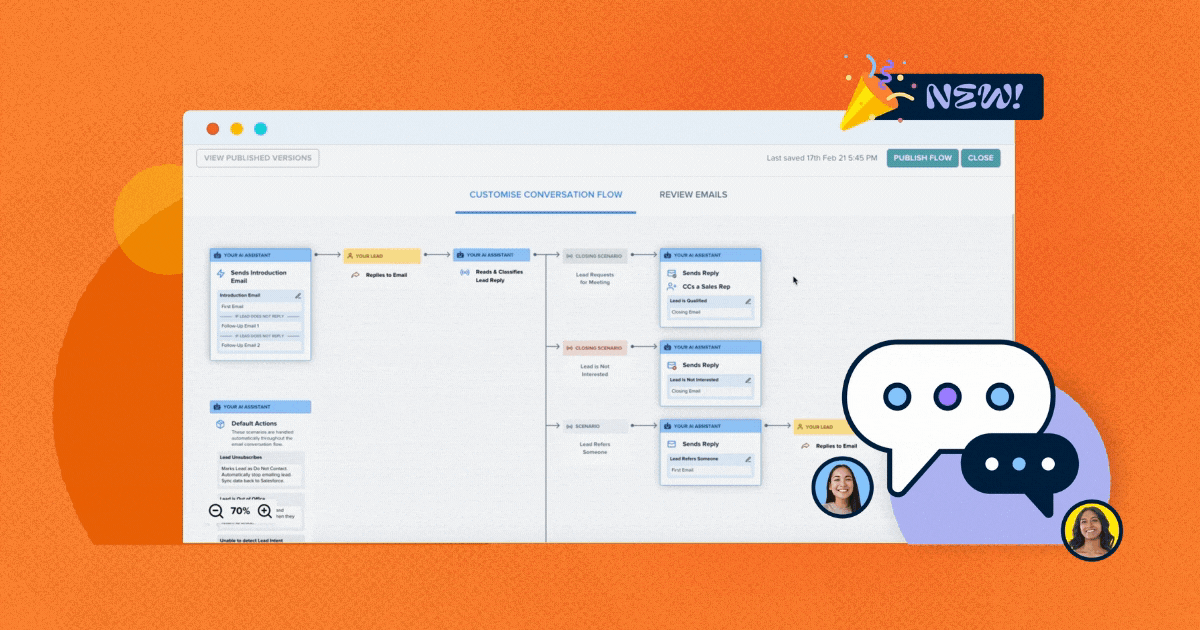
Demand generation and marketing teams generate more leads at the top of the funnel than ever in this new digital-first world. Saleswhale helps ensure those...
1 MAR 2021
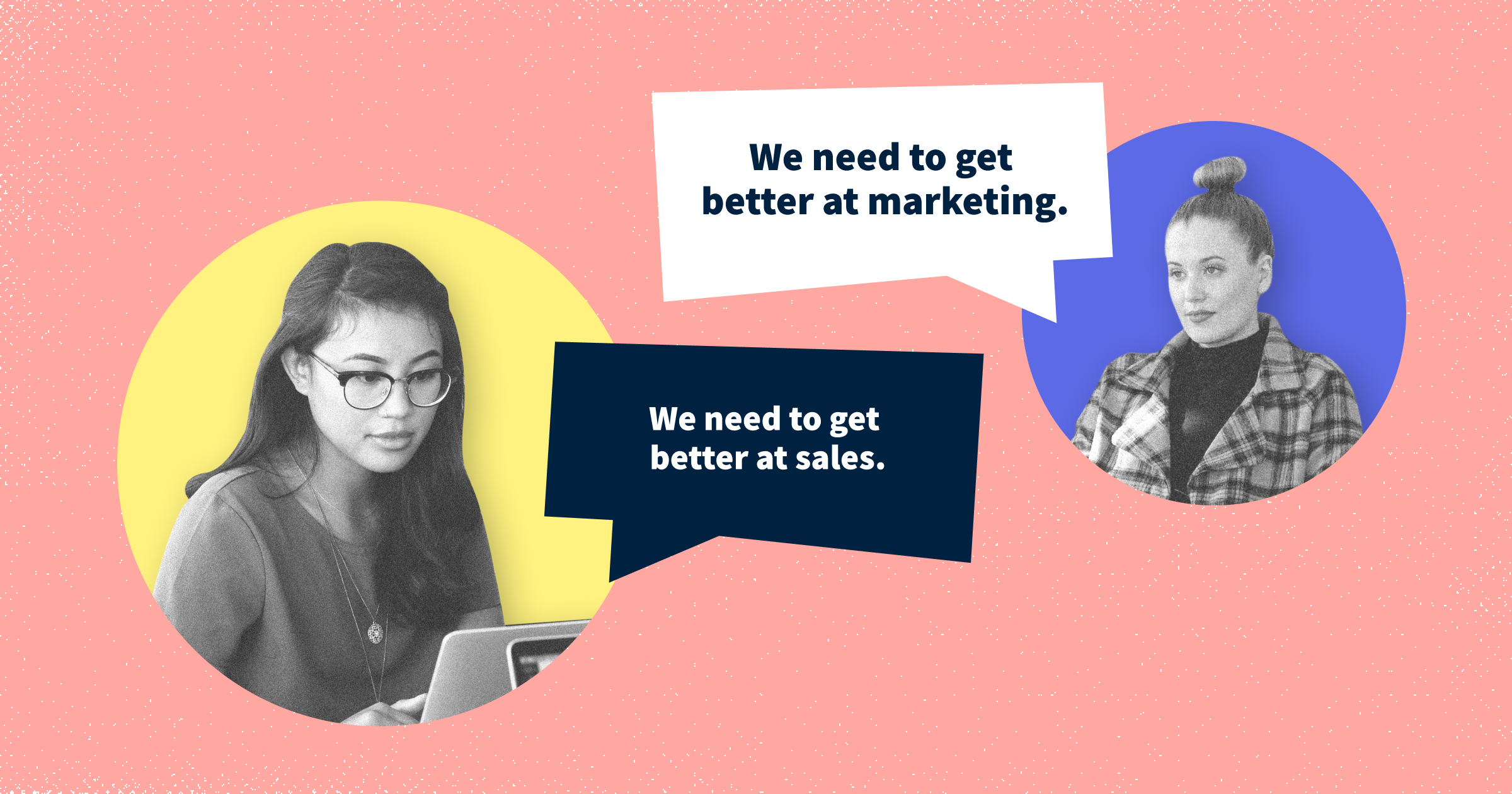
Marketers that focus on MQLs end up doing the wrong things in order to achieve the metrics. So I changed it.
16 JUN 2020
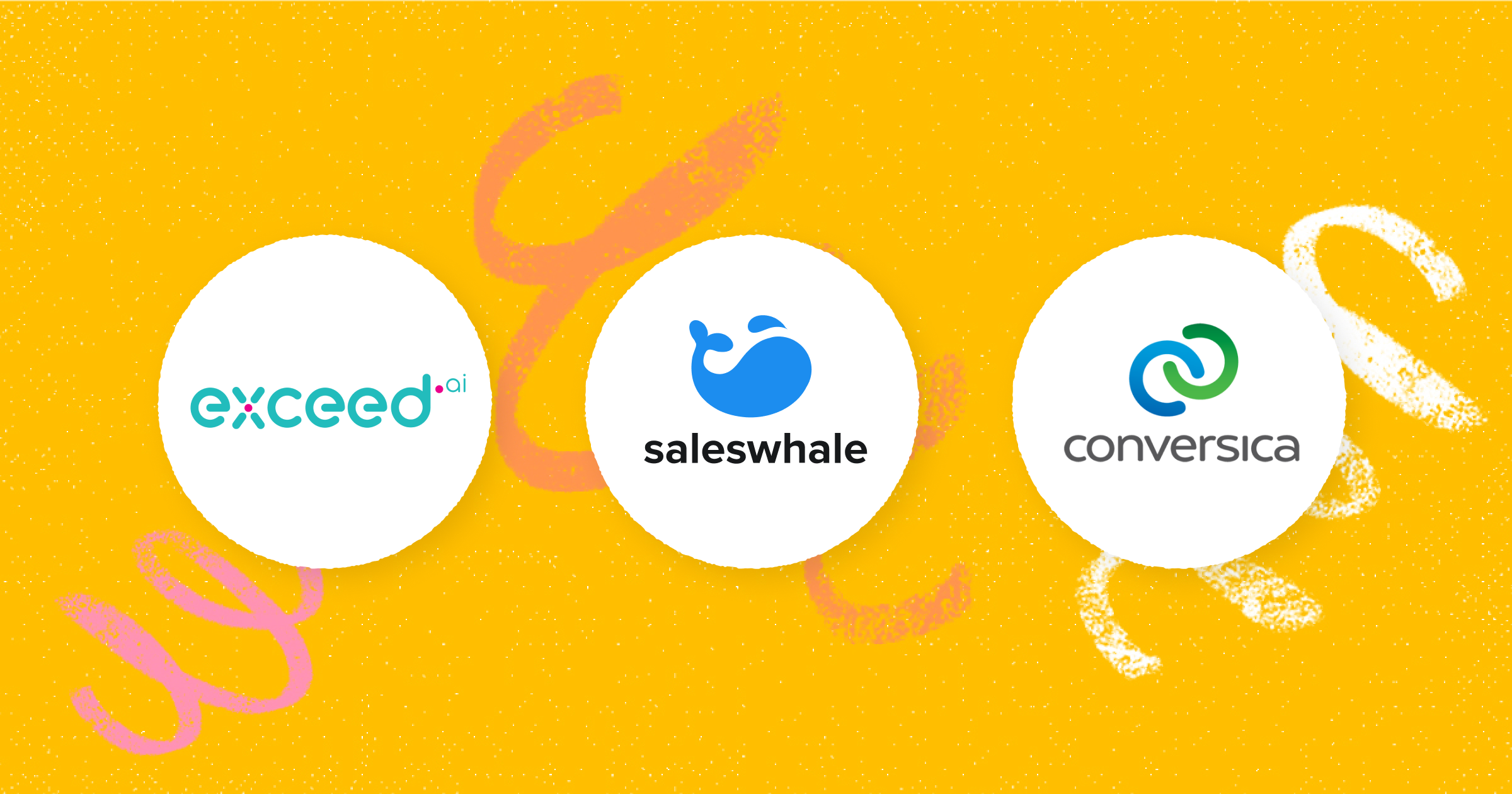
Conversica isn't the only player out there. Learn how Saleswhale and Exceed.ai compare and make an informed decision.
15 APR 2021
By providing your email you consent to allow Saleswhale to store and process the personal information submitted above to provide you the content requested.
You can unsubscribe at any time by clicking the link in the footer of our emails. For information about our privacy practices, please visit our privacy page.